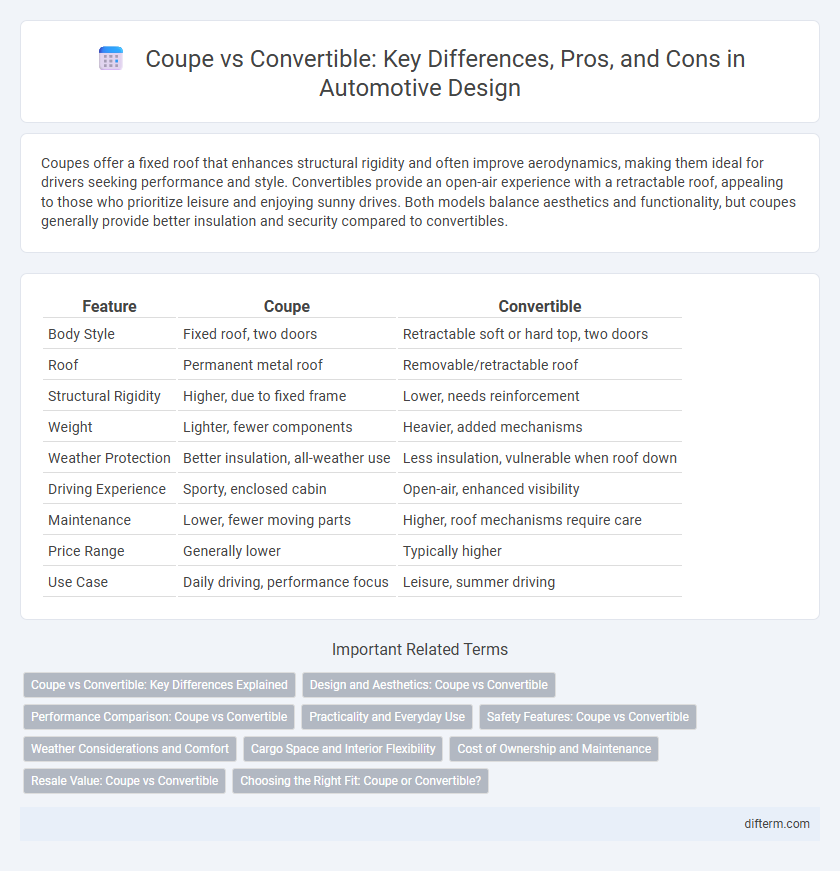Coupes offer a fixed roof that enhances structural rigidity and often improve aerodynamics, making them ideal for drivers seeking performance and style. Convertibles provide an open-air experience with a retractable roof, appealing to those who prioritize leisure and enjoying sunny drives. Both models balance aesthetics and functionality, but coupes generally provide better insulation and security compared to convertibles.
Table of Comparison
| Feature | Coupe | Convertible |
|---|---|---|
| Body Style | Fixed roof, two doors | Retractable soft or hard top, two doors |
| Roof | Permanent metal roof | Removable/retractable roof |
| Structural Rigidity | Higher, due to fixed frame | Lower, needs reinforcement |
| Weight | Lighter, fewer components | Heavier, added mechanisms |
| Weather Protection | Better insulation, all-weather use | Less insulation, vulnerable when roof down |
| Driving Experience | Sporty, enclosed cabin | Open-air, enhanced visibility |
| Maintenance | Lower, fewer moving parts | Higher, roof mechanisms require care |
| Price Range | Generally lower | Typically higher |
| Use Case | Daily driving, performance focus | Leisure, summer driving |
Coupe vs Convertible: Key Differences Explained
Coupes feature a fixed roof, offering enhanced structural rigidity, improved aerodynamics, and better noise insulation compared to convertibles. Convertibles provide an open-air driving experience with a retractable roof, sacrificing some stiffness and insulation for versatility and style. The choice between coupe and convertible depends on priorities like performance, weather adaptability, and aesthetic preference.
Design and Aesthetics: Coupe vs Convertible
Coupes feature a fixed roof design that enhances structural rigidity and offers a sleek, aerodynamic silhouette prized in automotive styling. Convertibles provide an open-top experience with a retractable roof, blending sporty aesthetics with versatile design but often sacrificing some body stiffness. The choice between coupe and convertible significantly impacts visual appeal, with coupes emphasizing streamlined elegance and convertibles highlighting freedom and dynamic lines.
Performance Comparison: Coupe vs Convertible
Coupes typically offer superior performance due to their rigid roof structure, resulting in enhanced chassis stiffness and improved handling dynamics compared to convertibles. Convertibles often weigh more because of reinforced frames and convertible mechanisms, which can slightly reduce acceleration and cornering agility. Engine power outputs may be similar in both body styles, but the coupe's optimized aerodynamic profile usually provides better high-speed stability and fuel efficiency.
Practicality and Everyday Use
Coupes offer superior structural rigidity and better insulation from weather and noise, making them more practical for daily commuting and long drives. Convertibles prioritize open-air experiences but often compromise on trunk space and cabin comfort, which can limit their usability in diverse weather conditions. For everyday use, coupes provide a balance of style and functionality, while convertibles are ideal for drivers prioritizing leisure and seasonal driving.
Safety Features: Coupe vs Convertible
Coupes typically offer enhanced safety features due to their fixed roofs, which provide better structural integrity and improved rollover protection compared to convertibles. Convertibles often include reinforced frames and advanced airbag systems to compensate for the lack of a permanent roof, but they may still have higher risks in side-impact collisions. Both vehicle styles incorporate modern safety technologies such as electronic stability control and advanced driver-assistance systems, yet the coupe's rigid structure generally offers superior crashworthiness.
Weather Considerations and Comfort
Coupes offer superior insulation and weather protection, making them ideal for harsh climates with cold temperatures or heavy rain. Convertibles, while providing an open-air driving experience, may expose occupants to wind, occasional water leaks, and temperature fluctuations, impacting overall comfort. Choosing between a coupe and a convertible depends heavily on regional weather patterns and personal tolerance for variable cabin conditions.
Cargo Space and Interior Flexibility
Coupes typically offer more cargo space due to their fixed roof design, allowing for larger trunk capacity compared to convertibles. Convertibles sacrifice some storage space to accommodate the retractable roof mechanism, resulting in reduced interior flexibility. Interior adaptability in coupes supports greater passenger comfort and cargo management, making them more practical for daily use.
Cost of Ownership and Maintenance
Coupes generally offer lower cost of ownership and maintenance due to their simpler roof mechanisms and fewer moving parts compared to convertibles. Convertible tops often require specialized repairs and replacement that increase long-term maintenance expenses. Insurance premiums for convertibles also tend to be higher because of increased risk factors like theft and weather-related damage.
Resale Value: Coupe vs Convertible
Coupes generally retain higher resale value compared to convertibles due to their structural rigidity and broader appeal in the automotive market. Convertibles tend to experience accelerated depreciation because of potential weather-related wear and a more niche buyer base. Data from Kelley Blue Book highlights that coupes often maintain 10-15% more of their original value over a five-year period than comparable convertible models.
Choosing the Right Fit: Coupe or Convertible?
Selecting between a coupe and a convertible depends on driving preferences and lifestyle needs. Coupes offer superior structural rigidity and better weather insulation, enhancing performance and comfort. Convertibles provide open-air driving experiences and stylish appeal but may sacrifice some noise reduction and trunk space.
coupe vs convertible Infographic

 difterm.com
difterm.com